Lifestyles

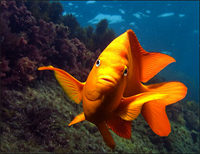
Hypsypops rubicundus. The state marine fish of California. The only species of damselfish that lives outside tropical reefs, preferring cool clear water over rocky bottoms, crevices and kelp beds off the coasts of California and Baja California. Photo by Dave Rudie at Santa Catalina Island, 2009.
How do fishes live? Where do they live and how do they make a living? What kind of hours do they keep? Their communication technologies? Favorite foods? How do they attract mates?
Delve into the personal lives of fishes. Learn about a variety of lifestyles.
Find out about how lifestyles depend on physiology and behavior. Different physiology and bahaviors give each fish the advantage it needs to overcome competitive and environmental challenges in specific habitats.
Longevity show

Two months to over a century - that's the long and the short of it, the great spectrum of lifespans of fishes.
The longest-lived fishes outlive the longest-liveed terrestrial animals including humans, tortoises, elephants and parrots. Unlike terrestrial animals, many fish keep growing throughout their lifetime, although at a slower rate when they are old. Like other living things, those that live in captivity may live longer or shorter lives than they would in natural habitats.
Short-lived Fishes

 Zoom
Pygmy goby
Eviota sigillata
Zoom
Pygmy goby
Eviota sigillataImage courtesy National Museum of Natural History, Division of Fishes, Smithsonian Institution. Photographer - Jeffrey T. Williams.
More about short-lived fishes: • Fish is Shortest
Lived Vertebrate • Fish that Live Fast,
Die Young

 Zoom
Zoom
Image courtesy photographer - Günther Schmaus.
In Zimbabwe where Turquoise Killifish live, they hatch from eggs that have lain dormant since the last year and occupy temporary pools of water that form just after annual rains.
The progesssion of the fish's life, from hatching, its juvenile to adult transformation, and egg-laying is extremely rapid, taking place before the water dries up and the fish dies.
But the other small fish, the Pygmy Goby, lives in a coral reef, so the reasons for a short lifespan vary. In both cases, scientists are very interested in the studying these short-lived fishes to understand more about the process of aging.
Long-lived Fishes
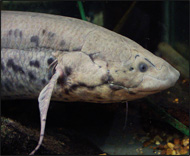
 Zoom
African Lungfish
Protopterus annectens
Photographer and © Dean Hendrickson.
Zoom
African Lungfish
Protopterus annectens
Photographer and © Dean Hendrickson.
Lungfish are relatively long-lived. Austrialian lungfish (Neoceratodus forsteri, such as "Granddad" at the Shedd Aquarium in Chicago and "Methuselah" at the Steinhart Aquarium in San Francisco are the oldest documented fish kept in aquaria.
the Shedd Aquarium • Australian Lungfish at
the Steinhart Aquarium • Estivation in the Africant
Lungfish
TO THINK ABOUT
Revealing their age show

TO THINK ABOUT
Fish otoliths, fish scales, tree rings and coral growth bands are used to tell the age of living things. What time-range does each cover?
Can you tell the age at which a mummy died?
When can growth rings be better at telling age than tooth wear or wrinkling?
How are various materials used to tell the history of the Earth's climate in the distant past, beyond the lifespan of animals that live now?
How do we know the age of a fish? We know the lifespan of fishes we've kept in captivity, but accurate lifespans of wild fishes are more difficult to determine.
Like trees, certain parts of fishes grow annual rings that can be counted to determine age - the bones in the ears, scales and vertebra in some sharks.
The method is straightforward, but forensic specialists must recognize exceptions, when one ring doesn't correspond to one year. Many exceptions occur for a variety of complex factors. The preliminary investigation of confirming the growth rate of rings for a particular species of fish is called validation. Like forensic evidence that sets a timeline for a crime - such as the development of insects found on homicide victims - if the assumptions about rate of development are incorrect whether otolith, scale, vertebra or blow fly, the timeline is also incorrect.
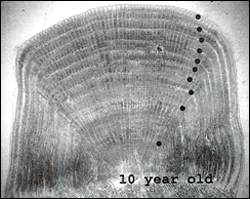
 Zoom
Zoom
To learn more:
How many fish can be safely caught each year without causing unrecoverable declines in population? It depends on the reproductive rate of particular fishes, and total numbers of existing fish (the stock). Part of "fisheries management" is determining how many are safe to catch and alloting the safe catch to different groups of people.
Fisheries managers need to know the reproductive ages of fishes and their lifespan. Fishes that occur in greater numbers, reproduce at a younger age and have more young are more likely to withstand higher rates of fishing than ones that are few, reproduce later in life and produce few young like many sharks. The Bull Shark reaches reproductive age between 10-18 years of age, has a gestation period of 10-11 months and 1-13 pups at a time. Although relatively few survive, numerous Atlantic Herring lay 20-200 thousand eggs at a time at 3-4 years of age.
The slower the rate of reproduction, the smaller the safe catch. Fishes such as the Orange Roughy have been estimated to live more than a century. As a graduate student, Krista Baker of Memorial University in Newfoundland, Canada put it this way - when you dine on orange roughy, "you could be eating a fish that was born when Lincoln was president." Although the very top age estimates of 150 years are debated, the Orange Roughy is clearly a long-lived fish. The Orange Roughy like other fishes that suddenly appeared in grocery stores has become increasingly scarce today.
Otoliths (ear bones)

 Zoom
Otolith (ear bone or earstone) of Common Snook (Centropomus undecimalis).
Image courtesy Florida Fish and Wildlife Conservation Commission.
Zoom
Otolith (ear bone or earstone) of Common Snook (Centropomus undecimalis).
Image courtesy Florida Fish and Wildlife Conservation Commission.
Fish have several earstones or otoliths in their heads.
More about otoliths: • Wikipedia - Otoliths • Alaska Fisheries Science
Center (AFSC)-
Age and Growth Program • Otoliths: Morphology,
Hearing, and Growth
How to sample: • 2005 Salmon Otolith
Port Sampling Guide
Interactive • Age Reading
Demonstration (ARD)
Image libraries: • AFSC Otolith Collection
Database • A Guide to Otoliths
from Fishes of the Gulf of
Mexico and Atlantic Ocean
Related stories: • Tiny otolith of Pygmy Goby • Otoliths and Thermal
Marking • Fish Ear Bones Affected by
CO2 • Fish Ear Bones Hold Clues
to Migration • Common Snook
Scales
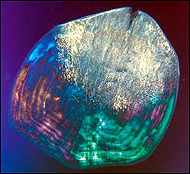
 Zoom
Zoom
image courtesy Avital Levy-Lior [29].
Shark vertebrae
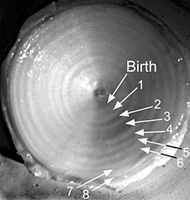
 Zoom
Image courtesy Dr. Steven Campana, Bedford Institute of Oceanography, Canada.
Zoom
Image courtesy Dr. Steven Campana, Bedford Institute of Oceanography, Canada.
• More about shark vertebra
Getting around show
Fish move their fins and entire body to propel forward, maneuver and stabilize themselves in water.. Although relatively easier for fishes to move up and down in water than air, it is more difficult to push forward against water than a solid surface.
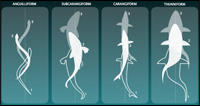
 Range of variation in the proportion of the tail and body motion involved in forward propulsion.
Range of variation in the proportion of the tail and body motion involved in forward propulsion.
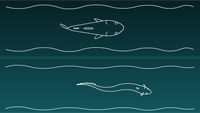
 Forward propulsion speed, degree of undulation and involvement of body motion.
Forward propulsion speed, degree of undulation and involvement of body motion.

 Styles of swimming involving fins other than the tail.
Styles of swimming involving fins other than the tail.
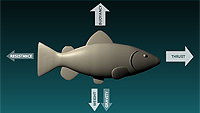
 Terms for directions of motion and rotation.
Terms for directions of motion and rotation.
Motion can be categorized in two ways - as translational and rotational. Translation refers to motion that gets somewhere whether it's up, down, forward or backward. Rotation refers to changes in three-dimensional orientation while staying in the same place. Fins are used to control both translational and rotational motion to swim forward and maneuver the body. In some situations, maneuverability wins over speed in catching a meal.
The tail fin and entire body of many fishes is used for forward propulsion (translational motion). Combined tail fin and body motion ranges from involving just the tail fin to greater lengths of the body up to the entire length of the fish.
The other fins are used primarily for maneuvering and stabilizing the body (rotational motion). The other fins include single unpaired median fins - dorsal and anal, and paired fins. Because fish aren't attached to the ground, they exhibit a much greater range of body orientation than humans.
The body and each fin can be moved in an undulating or non-undulating manner. The fastest fishes such as Bluefin Tuna and Mako Sharks minimize undulation and limit motion towards the tail. Slower fishes like eels and rattails undulate their entire body.
- Undulatory motion
Refers to rippling motion of the fin and/or body (sin wave
motion) where different parts of a single fin move in different
directions at any given time. The fish uses its muscles to
produce a ripple shape of the body or fins that moves towardsbr
the back of the body. - Non-undulatory motion
Refers to flapping or pivoting of a fin like the motion
of a door on a hinge. Does not involve migrating ripple.
TO THINK ABOUT
To swim forward, do fish move their tail fins and body by producing a standing or travelling wave?
Can fish swim backwards?
TECHNOLOGY
UNDERSTANDING FISHES
Communication show
Slated for Phase II.
Look for this section in the future.
Bioluminescence
ACTIVITY
Differences in the propogation of sound vs. light in air and water.Maintaining life Look for this section in the future.
Slated for Phase II.
Look for this section in the future.
Sensing their world Look for this section in the future.
Reproduction Look for this section in the future.
Slated for Phase II.
Look for this section in the future.
Transformation Look for this section in the future.
Slated for Phase II.
Look for this section in the future.
Dining preferences Look for this section in the future.
Slated for Phase II.
Look for this section in the future.



